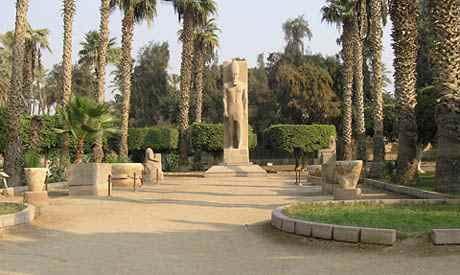
The Mit-Rahina archaeological site
While on routine inspection at Mit-Rahina, the Tourism and Antiquities Police uncovered on Tuesday a plastic bag concealing Ancient Egyptian artefacts. The bag was found half-buried in the botanical area behind the Hathor Temple archaeological site, located 24 km south of Cairo.
Minister of State for Antiquities (MSA) Mohamed Ibrahim told Ahram Online that the bag contains seven objects, three of which were reported missing from the Mit-Rahina gallery during the violence that erupted in the aftermath of the January 2011 Revolution. The other four items, he said, resulted from illegal excavation in the site.
Adel Hussein, head of the MSA's Ancient Egyptian Archaeological Section, explains that the three previously missing objects include a partly-damaged clay plate, a red clay pot and an alabaster cylindrical pot with a round base.
The other four objects are also clay pots of different shapes, colours and sizes.
The seven uncovered objects, now in custody, will be transferred to the Mit-Rahina gallery for restoration once investigations are concluded.
Mit-Rahina, historically known as Memphis, was the capital of Ancient Egypt for over eight consecutive dynasties in the Old Kingdom.
The city reached its peak during the 6th Dynasty, becoming the epicentre of god Ptah's worship, the Egyptian god of creation and artworks.
With the rise of Thebes and the New Kingdom, Memphis briefly declined after the 18th Dynasty, becoming the second largest Egyptian city until 641 CE, before it was eventually abandoned, turning into a stone quarry for the surrounding settlements.
Memphis now houses the ruins of Ancient Egyptian, Ptolemaic as well as Graeco-Roman temples and chapels.
Short link: